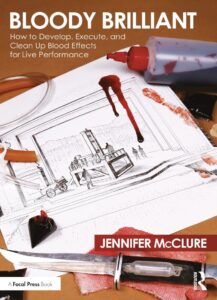Ash
Greycel or Blackcel (shredded paper) can be used to simulate a covering of ash or as airborne ash. It is however NOT flame-retardant, so should be used with care.
Rubber Crumb could also be used.

Bloody Brilliant
Blood
See also the book Bloody Brilliant by Jennifer McClure which brings together a lot of resources about making and using blood effects on stage. (Amazon UK or Amazon USA)
Dirt
See Sand below
Dust
Fullers Earth (aka Bentonite) used to be a good way to achieve a dusty look either on costumes or on set pieces / props. However, as safety standards have improved, it’s become clear that any dust / particles in the air can be an irritant, and should be avoided unless there are control measures in place to prevent actors from being near the effect. For this reason, we cannot recommend you use ANY dust-like material on stage without professional advice.
Cat Litter provides a larger-clumped equivalent.
There are reports of problems with singers / actors (and audience) inhaling the dust (it’s a lung and eye irritant) so this effect should not be widespread, or used to create a dusty atmosphere – it’s only for localised small effects.
Flour, corn starch, sugar or other organic products should NOT be used on stage as they are highly combustible in dust-form.
Edible Dirt, Edible Mess
A careful approach is required to ensure the material the actors have to eat is not contaminated by any other materials. The same material used to simulate dirt or mess which is handled, cannot be the same material that’s eaten. Companies such as MessySupplies.com produce a range of materials which can be varied in colour, consistency, and dryness, and can be food safe. Contact them for advice.
Feathers
Real feathers can bring on allergies in asthma sufferers. Synthetic or fake feathers are a suitable replacement but care should be taken as they are most likely flammable.
Food – Pies
MessySupplies sells a range of pie and slosh products (in a range of colours) for food fights or pantomime slosh scenes.
Foodstuffs
Gunge
MessySupplies sells a range of gunge mix products (in a range of colours). You can buy product Natrosol (in the UK) which is the main food-grade thickener used by TV production companies from chemical suppliers (in large quantities). In the USA, Methylcelluloe (Methocel) is used instead.
Be aware that gunge can be very slippery on the floor, so ensure you have risk-assessed the activity carefully.
Avoid using flour for gunge mixes, as it will take on a gluey texture which makes clean up very hard.
Link: BBC Science Focus – The Sticky Truth – Here’s What Gunge on Kids’ TV Shows is made from.
Hairspray
Real Hairspray should not be used on stage. The safest option is either water in a can (used to hydrate dried skin) or Diffusion Spray, which may be more visible.
Musson Theatrical in the USA sells Pretend Hairspray
Mud
Mud effects on scenery can be created using products such as Flints Mud.
Rubble
Rubber Crumb could be used, along with foam chips / offcuts dipped in paint then squeezed out. The foam will need to be treated with flame retardant.
Polystyrene / Styrofoam can be used in chunks, which can then be coated with Rosco Foamcoat (to provide a hard-wearing flame retardant surface)
Sand
Sand can be problematic – use Play Sand where possible (available in natural colour or white) which has been cleaned and is suitable for children to use.
Silicosis is a lung condition resulting from breathing in dust containing silica (sand) so any show using sand should include this in risk assessments.
Sand Floor
The amount of sand in use should be reduced to a minimum – take a sample of the sand you’re proposing to use to a local carpet company, and buy a sand-coloured carpet to cover the space with a thin layer of sand on top. The carpet will hold the sand in place and will maintain the sandy colour even if the sand gets moved around.
A plastic liner (e.g. pond liner) should be used to line the stage floor, with overlapping taped seams, to prevent moisture or sand from damaging the stage floor or from getting into the sub-stage area.
Sand Dunes
Use carpet and existing platforms to achieve the size / shape for the dunes, again with a thin layer of sand on top.
Don’t forget you need to have a plan for getting rid of the sand after the show has ended.
Alternatives
Ground-up cork can be used instead of sand, with more manageable results and less risk (and less weight).
Maryland Cork (USA)
Snow
More information coming soon!
Keywords: make fake blood, faux dirt, fake dirt,



